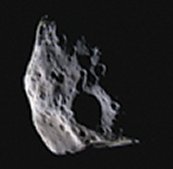Saturnian moonscape
Scientists have obtained their closest view yet of Saturn’s tiny moon Epimetheus. Taken by the Cassini spacecraft, the portrait shows that the moon, whose name in Greek means “afterthought”, has an irregular shape and is pocked with soft-edged craters. The high density of these craters implies that the surface of Epimetheus is several billion years old.

Once every 4 years, the 16-kilometer-wide body exchanges orbits with Janus, a slightly bigger Saturnian moon. The gravitational gyrations of these shifts create waves within Saturn’s icy rings. Spectra of Epimetheus taken by Cassini’s visual and infrared mapping spectrometer indicate that the moon is mostly water ice.
Cassini began orbiting Saturn on July 30 and will be exploring the planet and its moon for at least 4 years. NASA recorded the image of Epimetheus on March 30 and released it on April 27.







